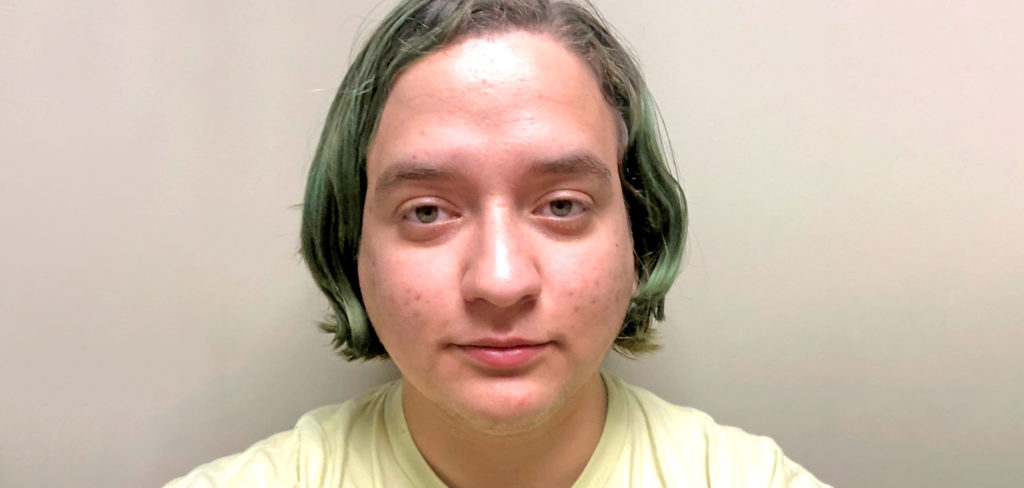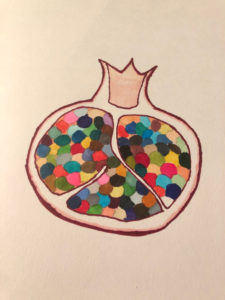
An Intersectional Artist
Frances Zuckerbrod’s pieces is published in a queer Jewish zine.

Frances Zuckerbrod has reason to feel proud during the High Holy Days this year.
The 21-year-old Texas A&M horticulture major submitted a piece of artwork to be included in a zine for the national Jewish LGBTQ nonprofit Keshet. They liked it so much they asked to print the drawing on items they plan to sell during this year’s High Holy Days.
Keshet is a Hebrew word meaning rainbow, the symbol of LGBTQ Pride. The national nonprofit organization was founded in 1996 in Boston by Jonathan Krasner and Jared Goldfarb to advocate for LGBTQ equality in all facets of Jewish life—synagogues, Hebrew schools, day schools, youth groups, summer camps, social-service organizations, and other communal agencies. They develop the leadership skills of LGBTQ Jewish teens, train Jewish educators to prevent anti-LGBTQ bullying, celebrate LGBTQ Jewish identity, and mobilize Jewish communities to protect marriage equality and transgender rights.
Zuckerbrod, a Jewish person who identifies as transmasculine, nonbinary, and pansexual, was thrilled to have his art chosen.
“I submitted my artwork to their zine without being sure they’d want to publish it,” he says. “Having them offer to pay me to use my artwork beyond publishing it in the zine was a pleasant surprise! The piece they selected is an illustration of a cross-section of a pomegranate with multi-colored seeds. The pomegranate is a symbol I’ve seen a lot in Jewish artwork, and I wanted the variety of colors in the seeds to reflect the diversity within the Jewish community and the LGBTQ+ community. It was an image that came to mind when I saw the prompt for Keshet’s zine, ‘At the Intersection of Queer and Jewish.’”
How does Zuckerbrod handle that intersection?
“I tend to present myself however I feel like presenting on any given day,” he says. “Sometimes this means I look feminine, or masculine, or somewhere in between. I use he/they pronouns, as well. When I met my girlfriend, who is a trans woman, I started to learn more about trans identities. I was also interested in Japanese street fashion at the time, and part of what drew me to it was that people in that community often experiment with different ways of presenting themselves, regardless of biological sex. I happened to like some of the more masculine or androgynous styles under that umbrella. What really solidified my understanding of myself was realizing that it was OK to identify as something besides a man or a woman, and that I felt most comfortable doing that.”
Coming out to his family wasn’t too much of an issue for Zuckerbrod.
“My immediate family is fairly small,” he says. “My dad is a single gay man, so I was pretty sure he and my sister would be accepting. Things were a little rougher with them than I expected, but that mostly came from a place of concern, and it’s getting better. I’m still working on informing extended family as it comes up, and I’m not really concerned with how they’ll react. My grandparents passed away before I was able to come out to them, and I suspect it would have been more difficult for them to accept me.”

Being queer at Texas A&M isn’t always easy. The school has a history of discrimination—specifically, a six-year long case fought in the courts when Texas A&M refused to officially recognize the Gay Student Services Organization on the grounds that homosexuality was illegal in Texas. Ultimately, in 1984, the U.S. Fifth Circuit Court of Appeals ruled in favor of the students, saying the university had denied them their First Amendment rights. Texas A&M was ranked consistently on Princeton Review’s list of “Unfriendly Schools for LGBT Students” from 2009 until 2015. People that live near A&M’s College Station campus sometimes refer to it as “Closet Station,” but things are getting better with queer student organizations being more visible and vocal.
“I don’t typically explain my gender identity to everyone I meet at my university,” Zuckerbrod admits. “I’m out to my friends in the LGBTQ organizations I’m involved with, and if a faculty member or classmate asked me for my pronouns, I do answer honestly. I just don’t necessarily look like someone who people would assume uses he/they pronouns, so usually people default to she/her. I don’t always have the willpower to correct them, and it can be hard for people to adjust even when I do. It doesn’t help that there’s a pretty vocal conservative element at A&M, but I tend to approach things that way in any situation where I’m uncertain about coming out. I’d like to be more open during my senior year and beyond that, though.”
For more on Keshet and Zuckerbrod’s merchandise, visit keshetonline.org.
This article appears in the August 2022 edition of OutSmart magazine.










